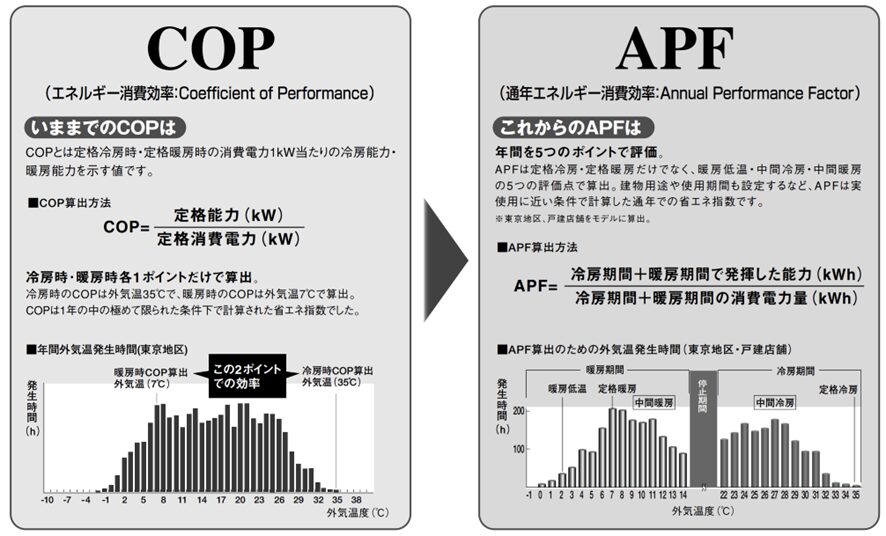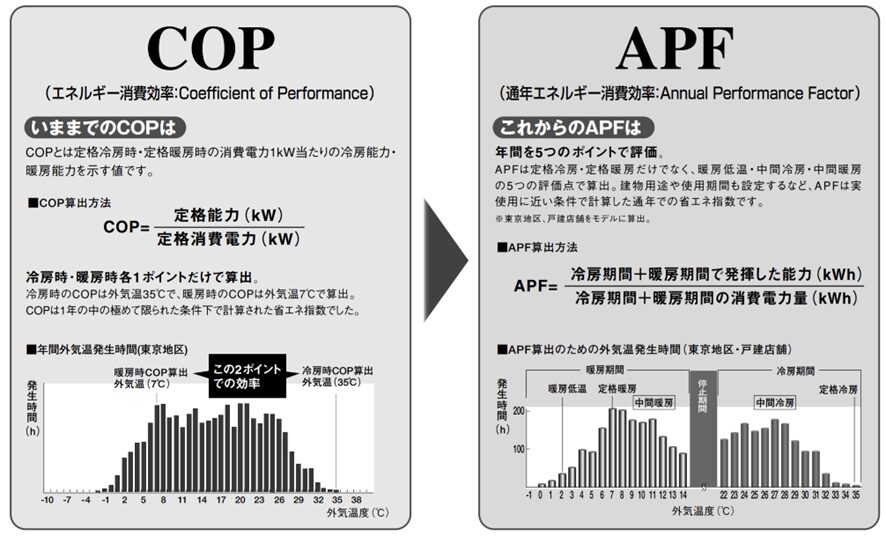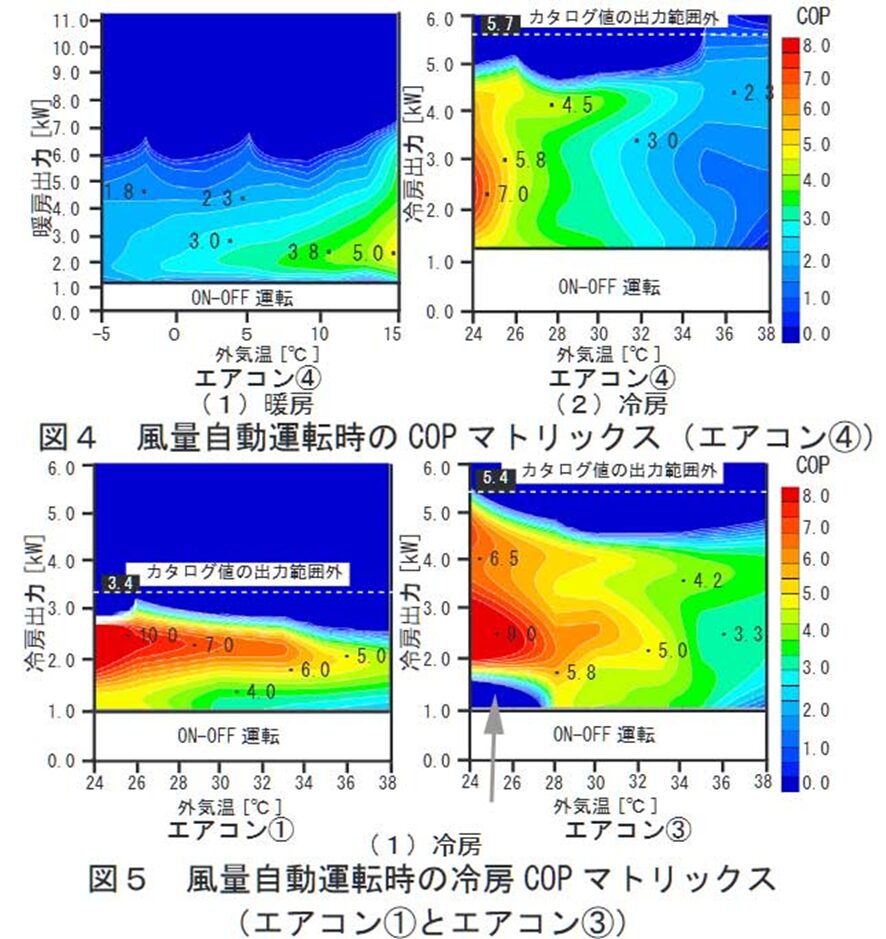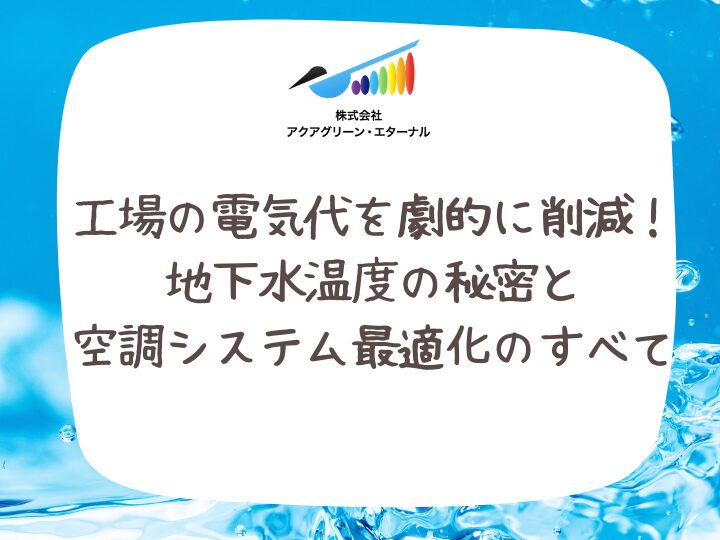Air conditioning efficiency can be discussed in terms of "actual operation COP"! Differences between air conditioning methods and the benefits of groundwater air conditioning

What is COP?
COP (Coefficient of Performance) is an index that shows the cooling/heating capacity (kW) per 1kW of power consumption under a specified temperature condition. This index is listed in almost all catalogs of heating and cooling equipment. Naturally, the higher the COP number, the higher the air conditioning capacity and the less electricity it can be operated with.
Although COP is gradually improving thanks to the development efforts of air conditioning equipment manufacturers, the approximate value is basically determined by the air conditioning method and usage conditions. Therefore, understanding the COP characteristics and deciding which air conditioning method to adopt is important for energy-saving design.
Air conditioning method and COP
1. Boiler
Although the heat source used can be fuel or electricity, the COP is always less than 1 because the water or air is heated directly with the heat provided. Although it is getting closer to 1 through various efficiency and heat recovery technologies, it never heats up more than the heat provided. From an energy conservation perspective, it is not a very efficient device. However, since it can handle high temperatures that air conditioners cannot produce, and the difference is small when it comes to energy costs, it should be used in the right place.
②Absorption chiller/hot and cold water generator
Absorption chillers are devices that do not use alternative fluorocarbons, but use water as a refrigerant, and cool through the four processes of evaporation, absorption, regeneration, and condensation. They are used in centralized air conditioning in large facilities. They generally run on fuel, and have a COP of around 1.0 to 1.5. This is a much smaller value than that of air conditioners, but like boilers, it is not overwhelmingly worse when compared in terms of fuel costs.
③GHP
GHP, short for Gas Heat Pump, is an air conditioner that uses a gas fuel to drive the engine, as opposed to a typical air conditioner that uses electricity to drive the compressor. Electric air conditioners are sometimes called EHPs in contrast to GHPs. The COP of GHPs is often around 1.2 to 1.5, but one advantage is that the "actual operating COP," which will be described later, is less likely to drop, especially in winter.
④Air conditioner
Generally speaking, air conditioners refer to electric EHPs. There are many variations, such as packaged air conditioners and multi-air conditioners for buildings, depending on the size and shape, but the basic mechanism is the same, providing heating and cooling by compressing and expanding alternative fluorocarbons. It is currently the most widespread air conditioning method, and the COP indicated varies depending on the device. Most domestic manufacturers state a figure of 3.5 or higher, and some even state a surprising figure of 6 or higher.

Source: Daikin VRV X Series website
Pitfalls between catalog COP (rated COP) and "actual operation COP"
You might think that if the efficiency is that high, the latest air conditioners must be extremely energy-efficient, but there is a catch. This COP represents performance under certain conditions. In fact, due to the way air conditioners work, their efficiency varies greatly depending on factors such as the outside temperature. The higher the outside temperature, the lower the efficiency of cooling, and the lower the outside temperature, the lower the efficiency of heating.
These fixed conditions are generally based on the JIS rated conditions, and are set at an outside temperature of 35°C for cooling and 7°C for heating. The COP calculated based on this JIS rated standard is called the rated COP, and this value is usually used for the COP listed in the catalog.
However, this raises the question: what will the COP be in actual operation?
This is a big problem. It is not uncommon in Japan these days for temperatures to exceed 35°C in the summer, and it has become a daily occurrence. Furthermore, the temperatures announced by the Japan Meteorological Agency are measured under conditions that are less susceptible to the effects of direct sunlight and glare, and the outside temperature in places where air conditioners are installed is often higher than the temperatures announced by the Japan Meteorological Agency.
The same is true in winter, when people naturally use heating even when the temperature is below the rated condition of 7°C. In particular, when the outside temperature approaches 0°C, the outdoor unit freezes and the "defrost operation" state is triggered to melt the frozen air. During defrost operation, heating cannot be used and electricity is simply consumed. Energy saving performance cannot be measured by the COP on the catalog alone.

Source: From the blog "Read TV: Fun TV Stories to Read"
How much does the actual operating COP decrease?
Currently, an index called APF is also used as an index closer to actual operating conditions. APF (Annual Performance Factor) indicates the cooling and heating capacity (kWh) per kWh of power consumption when an air conditioner is used under certain conditions throughout the year. However, APF does not yet reflect the harsh operating environment of today. Rather, it evaluates low-load conditions in the middle of the year, and is detached from actual operating conditions.

Source: Mitsubishi Electric website
The Akabayashi Laboratory at Niigata University is attempting to perform a matrix evaluation of COP based on operating conditions. This clearly shows how much COP drops during periods of extreme heat and severe winter. Depending on the conditions, the COP can drop by 30% or more from the rated COP listed in the catalog. In order to achieve energy savings, it is necessary to consider the operating conditions of the air conditioner.

Source: Japan Refrigeration and Air Conditioning Industry Association website
Aqua Green Eternal Natural Air Conditioner
Our natural energy air conditioners use natural heat sources such as groundwater to provide air conditioning. The basic power source is only a blower fan and a water pump, making them extremely energy-efficient. For models with a cooling capacity of around 45kW, the fan consumes around 0.77kW of power. Even when the power consumption of the pump is taken into account, the power consumption is less than 2kW, resulting in an astonishing COP of over 20. Furthermore, since the "actual operating COP" is not affected by the outside temperature, the unit always exerts a constant capacity.

When considering air conditioning, we would appreciate it if you would take into consideration the differences in COP depending on the system, the difference between rated COP and actual operating COP, and the benefits of natural energy air conditioning.


